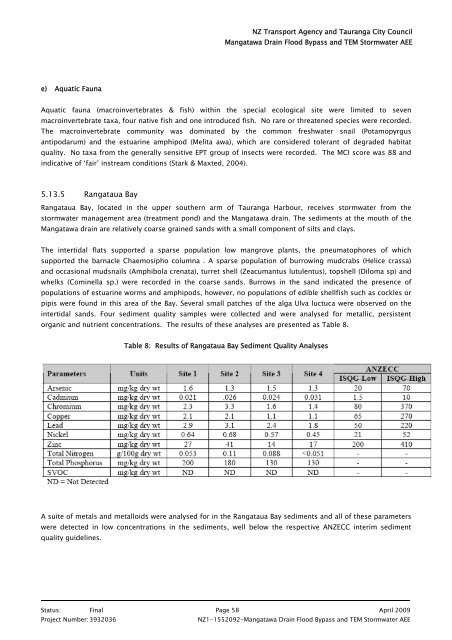2. Mangatawa catchment consents for earthworks, storm water ...
2. Mangatawa catchment consents for earthworks, storm water ...
2. Mangatawa catchment consents for earthworks, storm water ...
- No tags were found...
Create successful ePaper yourself
Turn your PDF publications into a flip-book with our unique Google optimized e-Paper software.
NZ Transport Agency and Tauranga City Council<br />
<strong>Mangatawa</strong> Drain Flood Bypass and TEM Storm<strong>water</strong> AEE<br />
e) Aquatic Fauna<br />
Aquatic fauna (macroinvertebrates & fish) within the special ecological site were limited to seven<br />
macroinvertebrate taxa, four native fish and one introduced fish. No rare or threatened species were recorded.<br />
The macroinvertebrate community was dominated by the common fresh<strong>water</strong> snail (Potamopyrgus<br />
antipodarum) and the estuarine amphipod (Melita awa), which are considered tolerant of degraded habitat<br />
quality. No taxa from the generally sensitive EPT group of insects were recorded. The MCI score was 88 and<br />
indicative of ‘fair’ instream conditions (Stark & Maxted, 2004).<br />
5.13.5 Rangataua Bay<br />
Rangataua Bay, located in the upper southern arm of Tauranga Harbour, receives <strong>storm</strong><strong>water</strong> from the<br />
<strong>storm</strong><strong>water</strong> management area (treatment pond) and the <strong>Mangatawa</strong> drain. The sediments at the mouth of the<br />
<strong>Mangatawa</strong> drain are relatively coarse grained sands with a small component of silts and clays.<br />
The intertidal flats supported a sparse population low mangrove plants, the pneumatophores of which<br />
supported the barnacle Chaemosipho columna . A sparse population of burrowing mudcrabs (Helice crassa)<br />
and occasional mudsnails (Amphibola crenata), turret shell (Zeacumantus lutulentus), topshell (Diloma sp) and<br />
whelks (Cominella sp.) were recorded in the coarse sands. Burrows in the sand indicated the presence of<br />
populations of estuarine worms and amphipods, however, no populations of edible shellfish such as cockles or<br />
pipis were found in this area of the Bay. Several small patches of the alga Ulva luctuca were observed on the<br />
intertidal sands. Four sediment quality samples were collected and were analysed <strong>for</strong> metallic, persistent<br />
organic and nutrient concentrations. The results of these analyses are presented as Table 8.<br />
Table 8: Results of Rangataua Bay Sediment Quality Analyses<br />
A suite of metals and metalloids were analysed <strong>for</strong> in the Rangataua Bay sediments and all of these parameters<br />
were detected in low concentrations in the sediments, well below the respective ANZECC interim sediment<br />
quality guidelines.<br />
Status: Final Page 58 April 2009<br />
Project Number: 3932036<br />
NZ1-1552092-<strong>Mangatawa</strong> Drain Flood Bypass and TEM Storm<strong>water</strong> AEE
















